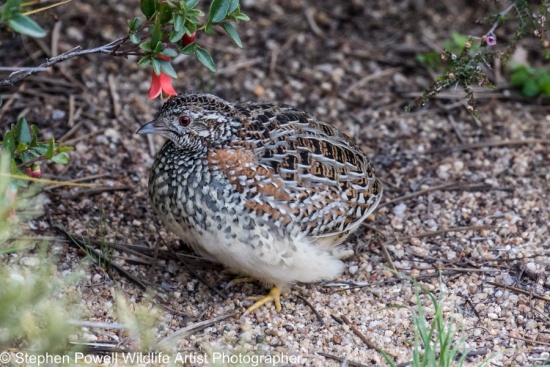- Turnix varius
Turnix varia
Identification
17–23 cm (6¾-9 in)
- Reddish-brown overall plumage
- Pale spots on forehead and breast
- Red eye
- Chestnut shoulders
Female is brighter than the male.
Juvenile is smaller and grey, more mottled, pale eyes.
Distribution
| Australia and Tasmania | |
Taxonomy
Forms a superspecies with Buff-breasted Buttonquail, Chestnut-backed Buttonquail and New Caledonian Buttonquail.
The scientific name was formerly spelled varia.
Subspecies
Two subspecies are recognized[1].
- T. v. scintillans - Houtman Abrolhos Islands (off sw Australia)
- T. v. varius - SW, e and se Australia and Tasmania
Habitat
Scrub, grassy woodland, open banksia, eucalypt and acacia forests, grassy clearings in dense forest, and heath.
Behaviour
Diet
There is not a lot known, however, grass seeds, insects and fruits are known to be consumed.
Breeding
Polyandrous. The clutch consists of 3-4 eggs which are incubated by the male for 13-14 days. They are fed by the male and reach adulthood in 23 days.
References
- Clements, J. F., T. S. Schulenberg, M. J. Iliff, D. Roberson, T. A. Fredericks, B. L. Sullivan, and C. L. Wood. 2017. The eBird/Clements checklist of birds of the world: v2017, with updates to August 2017. Downloaded from http://www.birds.cornell.edu/clementschecklist/download/
- Handbook of the Birds of the World Alive (retrieved Nov 2017)
- Birdata.com.au, Raw Data for Map
- Wikipedia
- BirdForum member observations
Recommended Citation
- BirdForum Opus contributors. (2025) Painted Buttonquail. In: BirdForum, the forum for wild birds and birding. Retrieved 1 May 2025 from https://www.birdforum.net/opus/Painted_Buttonquail
External Links
GSearch checked for 2020 platform.






